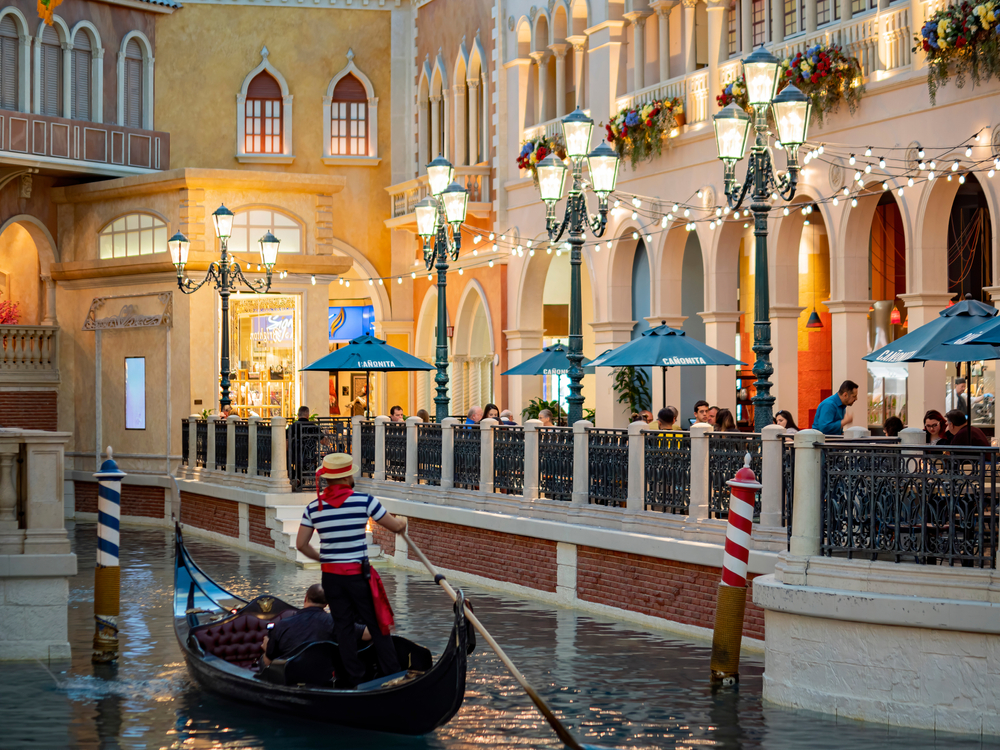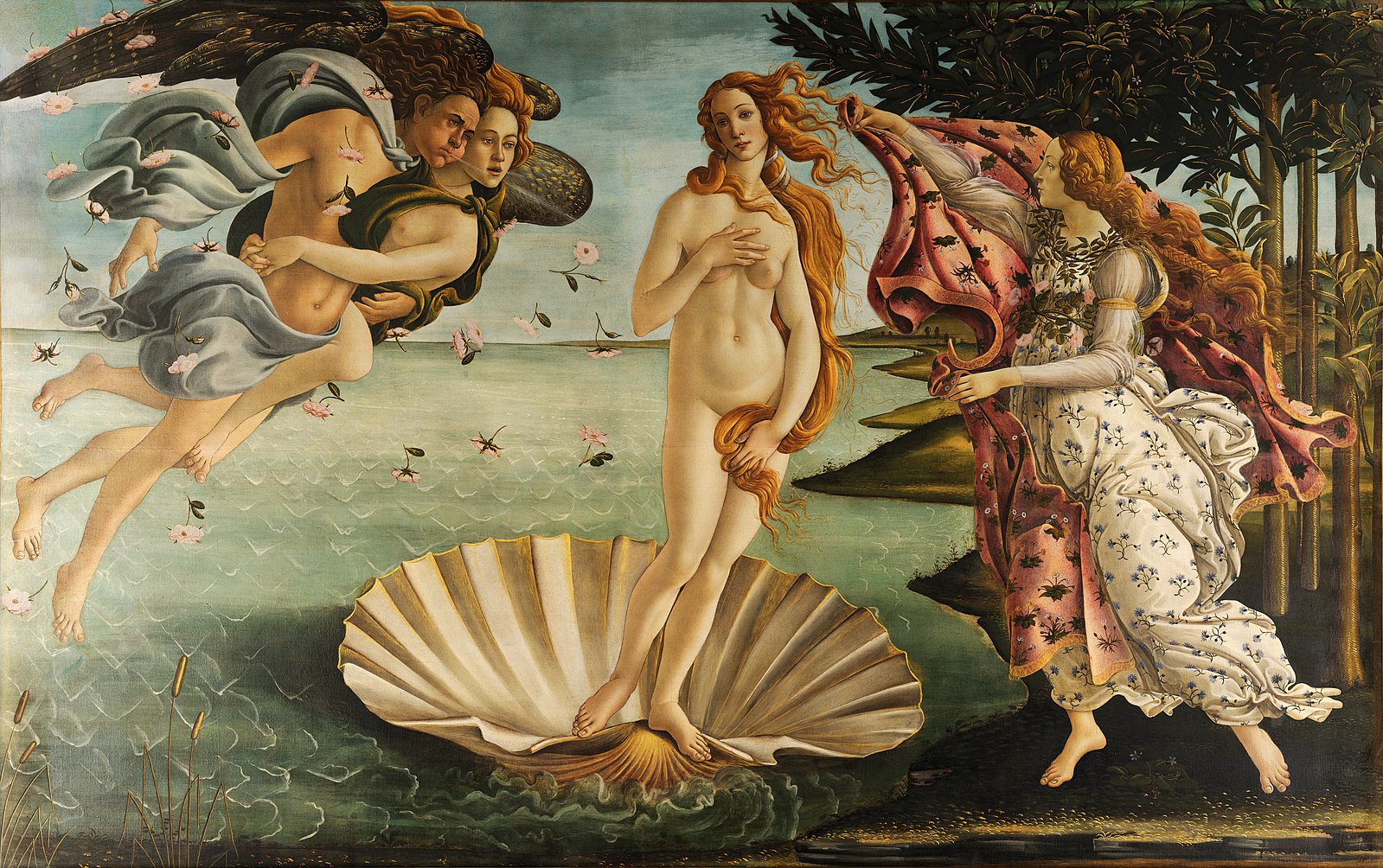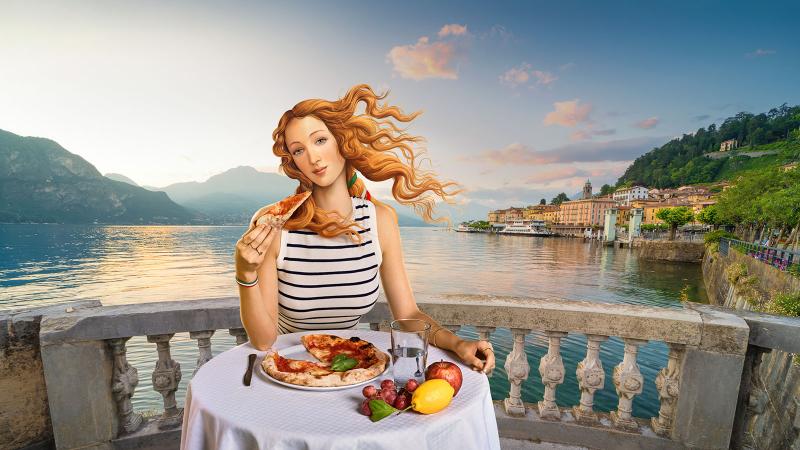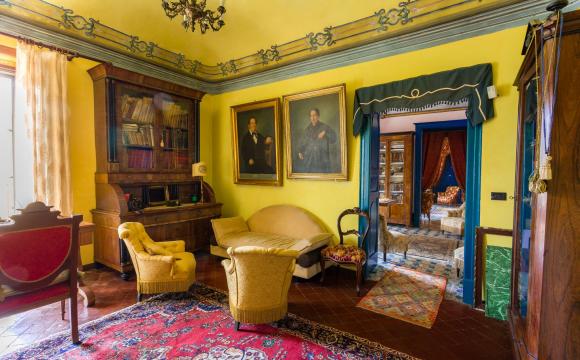In 2007, the Paris-based journalist Dana Thomas published a dense little book, Deluxe: How Luxury Lost its Luster, which quickly became a fixture on the syllabi of entry-level fashion school courses. Outwardly, it was a reportage on the bland massification of couture houses, a kind of elegant-elitist call to arms for righteous defenders of “integrity” in “aspirational” products. In hindsight, it was a statement on market homogeneity and a prescient, pre-Instagram dig into the costs of peddling illusions.
Deluxe overflows with examples of generic opulence gone global. One of the most memorable — particularly for Venice lovers, but also for anyone vaguely invested in Italy’s public image — comes when Thomas maps out Las Vegas’ road to worldwide retail renown. A turning point in the city’s evolution, she explains, was the 1999 opening of The Venetian, a $1.5 billion hotel-casino with a 500-thousand-square-foot wing called the Shoppes, “where families glide down an indoor Grand Canal in genuine gondolas, past palazzi that house not Casanova or Lord Byron, but Burberry and Jimmy Choo.”
Thomas’ barely-there mention of Vegas’ pretend-Venice playset sprang to mind on April 21, when a press release from ENIT — the Italian National Tourist Board — arrived in my inbox. It announced a €9 million “come to Italy” marketing push where simulations, green screens, and manufactured Grand Canals — in a manner of speaking — were not just methods in the playbook, but the very essence of the campaign’s non-message.
The illusion of wonder

Clunkily titled “Open to Meraviglia” — Open to Wonder — the government-backed campaign is being rolled out in international markets this week, beginning with tourism fair ATM Dubai. Video promotions and signage are planned for airports and rail hubs, with QR codes directing passengers to the official tourism portal of Italia.it. But thematically, everything takes root on social media, and revolves around Open to Meraviglia’s star, @venereitalia23, a digital paper doll-like rendering of Botticelli’s Venus, reimagined by the marketing minds at Armando Testa Group as a chirpy, elder-millennial Instagram influencer with a ramped-up contouring routine.
Eccola, here she is, Bot(ticelli’s) Venus! Venus eats pizza against a Lake Como green screen. Venus takes a selfie in a suspiciously empty Piazza San Marco. Venus wears a jewel-toned “going out top” straight from the clearance pages of SHEIN, ill fit obscured by manicured nails draped lissomely over her décolletage. Venus tee-hees coquettishly about her age, which is 30, or, okay, she confesses, you guys, “a wee bit more than that!” This Venus, transposed to the context of Instagram Reels, is neither relatable (as her Gen-Z-approval-craving engineers so wish her to be) nor resplendent (as the real thing genuinely is). She is another vacant, dead-eyed facsimile of a young woman — picture a Hailey Bieber wannabe who’s just undergone anesthesia — flattening all particularities of self and surroundings to meet the algorithm’s demands.
Italy will look good on your Instagram, she implicitly promises. As if you needed the reminder.
Italy, these days, looks good on what feels like everyone’s Instagrams. International visitors, according to ENIT, spent €77 billion in 2022. Back in October, the comedown of a year where every travel media outlet, including this one, was talking up “comeback travel,” a Vox piece by Rebecca Jennings went right for the throat with a dis of Positano: “The Instagram capital of the world is a terrible place to be.”
Jennings' guiding question: Did all this gleeful flooding of the web’s and world’s most obvious hotspots actually feel good offline, on the ground? Much of it didn’t and doesn’t, she argued; and much of the time, our collective obsession with trolling and scrolling for the “best of” everything is what's to blame. Positano itself, which makes routine appearances in that genre of articles where someone essentially just yells at you about not letting yourself die before you get there, has become “synonymous with the grandest of influencer travelscapes, clogging Instagram with photos of beautiful people on boats, staring back in wonder at the skyline behind them,” she wrote. “It is also the most unpleasant place I have ever been.”
Now is a useful time to remember something: For at least as long as there have been places to visit, cameras and souvenirs, travelers have crowded well-known heritage sites, taken photos and sought out trinkets, holding the moment and its memento in equal esteem. This is not, in and of itself, a terrible thing. “‘Rambles’ through Florence, such as the old guidebooks talk of, are a funny idea under present conditions,” Mary McCarthy wrote in The Stones of Florence, first published in 1959. “Many of the famous monuments have become, quite literally, invisible, for lack of a spot from which they can be viewed with safety.”
Yet Jennings argues that the altered circumstances of our present conditions have created the uniquely demoralizing force she terms “the Positano problem.” She and we know the issue is not with Positano itself, but the psychological and technological traps of algorithm-driven travel. Jennings’ gripe is not that too many people are traveling, either, nor that perfectly nice and reasonable folks sometimes just want to visit pretty places on vacation and take a few pictures along the way.
No, the “Positano problem” is more sinister, rooted in the growing Instagram feed- and “definitive guide”-driven encouragement to scale one’s inherently personal, small travel experiences and maximize them to Full Market Potential or even Optimum Authenticity. “Too many people [are] wanting to experience the exact same thing because they all went to the same websites and read the same reviews,” Jennings explains, which has created a mistaken belief “that if you do not go to this specific bar or stay in this exact neighborhood, all the money and time you spent on being here has been wasted, and you have settled for something that is not as perfect as it could have been.”
These are the basic conditions of our present — “consult Instagram first, physical world later” — that gave rise to Open to Meraviglia. But I doubt the creators thought about any of it that hard.
Is it the “Positano problem,” or the Ferragni effect?
The gap between how Open to Meraviglia’s vaguely defined target of “young people” views the campaign and how its architects thought they might is abundantly clear. In addition to the scores of various Open to Meraviglia-themed memes that are circulating, brutal jokes (“Ciao Venere, you on OnlyFans?”) and comments on the @venereitalia23 profile itself, attentive whippersnapper types have pointed out major technical errors in the campaign. A Tuscan marketing firm bought the web domain opentomeraviglia.it for just under €5 when they saw it was still unregistered, post-campaign announcement. A young Trieste-based filmmaker, Massimiliano Milič, was the first to point out that some of the stock video footage used in the initial presentation was filmed at a winery in Slovenia.
Most media coverage has spared none of these damning details, yet still betrays some signs of generational confusion about what actually might appeal to the Youth of Today. One veteran New York Times journalist framed Venus as a “hip fashionista” — referring to her that way twice, if you count caption text. The description didn’t sound too removed from ENIT’s own concept of Cool Venus, “dawdling with her smartphone, but wearing an elegant outfit.” Meanwhile, the top-liked comment on an Instagram post by a prominent twentysomething-geared streetwear publication described Venus far less generously: She’s “Chiara Ferragni, but wearing OVS.”
Mutually unflattering comparisons of this vacuous Venus to Ferragni, a Cremona-born influencer and entrepreneur, were immediate across Italian media — and not just in Gen-Z-heavy comment sections. Culture undersecretary and art commentator Vittorio Sgarbi made one of the more widely quoted jabs at both Ferragni and @venereitalia23: “Works of art [do their own] advertising for Italy, without the need to [dress them up in costume],” he told Italian press. “It’s Ferragni-like stuff.”
“Low-hanging fruit, but with high stakes” is my best stab at what Sgarbi might have meant by “Ferragni-like stuff.” The “high stakes” part could be confusing in the United States, where the 35-year-old Ferragni is a niche-y figure, familiar mostly to a subset of millennials who followed fashion blogs in their early-2010s heyday. Ferragni and her site The Blonde Salad were part of a first wave of internet phenoms who sent top magazines scrambling for their advertising dollars. (Faran Krentcil, writing in one such magazine last year, called her the “Mother of Dragons” of fashion influencers.)
But the Ferragni of Italy is an altogether different beast. Alongside her pop star husband Fedez, she is an around-the-clock cultural presence due to her colossal reach, a byproduct of her for-better-or-worse — and many do say worse — fusion of brand and personhood. The public vitriol and breathless adoration leveled at her are equally relentless, symbiotically shaping both her self-presentation and Italian media’s constant dissection of it.
In July 2020, Ferragni paid an after-hours visit to the Uffizi Galleries — the home, of course, of Botticelli’s real-life Venus — for a Vogue Hong Kong photo shoot. She shared, along with the host institution, a series of behind-the-scenes snaps on Instagram, writing in her caption: “Guys now It’s the best time to visit museums and @uffizigalleries is one of the most special in the world 🙏🏻.” That was it. Summertime visitors to the Uffizi aged 19 to 25 soon surged by close to 25%, peaking in the two weeks after her posts. That fact, palatable or not, is “Ferragni-like stuff.”
For all the talking heads and everyday Italians who accuse Ferragni of narcissism, of exploitation of her body and family for the sake of The Brand — hers — she and Fedez have championed social causes beyond Social™ causes. The “Ferragnez” apologists (am I them?) might point to the early days of the pandemic, when the couple ran a record-breaking, €4 million crowdfunding campaign for Milan’s San Raffaele Hospital; or to their 2021 support of proposed legislation that would have classified violence against the LGBTQ community as a hate crime; or to Ferragni’s 2022 meeting with Holocaust survivor Liliana Segre and subsequent visit to Milan’s Memoriale della Shoah; or to the 2023 Sanremo Festival, when Ferragni shone a light on the women of D.I.RE, an anti-domestic violence association. The couple, it’s clear, are more brands with breaths than in-the-trenches activists. But no one could credibly argue that the “Ferragnez” never use their platform to elevate others.
What Open to Meraviglia’s Venus elevates, by contrast, is the platform itself. What she promotes is not art nor a cause nor a country nor a line of products nor even her own beauty, but the general notion of “having a following,” even if it’s trailing nothing; of performing travel for an audience, real or imagined; of trip documentation not as a meticulous cataloging of discoveries but as Content Generation.
Ferragni — bolstered though she was by her upper-crust Milanese positioning and Bocconi-Barbie looks — sparked curiosity with her posts, built trust with a sufficient number of people, and eventually started telling those people where they might direct their attention, morphing only over time into a bloated megabrand, choking on its own (blonde) salad. Open to Meraviglia’s Venus would rather not waste caption space on trivialities like “building community” or “offering explanations” (or checking that “her” video footage was filmed in the country she’s been tapped to promote).
From the jump, @venereitalia23 introduces herself, in video form, as a “virtual influencer,” washed up on her shell and born as such, apropos of nothing. È così; it just is. A €9 million euro budget can still apparently give rise to the opening caption, “Hi there everybody! Welcome to my new profile page,” in case you forgot you were on a “profile page.” She goes on to throw a one-line bone to “the wonders of Italy” before imploring you: Follow me.
Bless her heart — sweet, dumb @venereitalia23. Her engineers have been accused of purchasing fake followers from India to trigger ten-thousandfold increases in “likes.” She captions a windswept selfie, posted on April 25, Italy’s Liberation — as in, from Nazi occupation and fascist rule — with “Freedom is wonderful. #25aprile.” The backdrop: A blue sky, otherwise known as blank universality in its Platonic form. Is this slice of sky in Italy? Slovenia? In Vegas-posing-as-Venice? Whatever.
@venereitalia23 “herself” is hard to take seriously, despite the reams of Italian think pieces and reactions she has inspired. The trends that birthed this Venus, though, are more worrying: heritage sites stripped of meaning and used as shufflable, green screen-like selfie backdrops; top-down yet context-free travel instruction from dubious sources; travel itself as a means not of growth or even fun, but of appearing, online, to travel, grow and have fun. All are cousins of Jennings’ persistent “Positano problem:” the fear-driven, for-a-limited-time-only, best-of-most-authentic-top-ten-must-do-before-you-die hive mind.
Will you be checking your body today, sir?
Earlier this spring, my brother and sister-in-law came to see me in Florence. One morning midway through the visit, my sister-in-law, affecting the tone a flight attendant in a pivotal film scene might use, asked my brother, “Sir, will you be traveling with your body today?”
Distracted by a sputtering Moka pot, I was only half sure I’d heard her correctly. She clarified that it had become a running joke of their trip. The pair — waking each morning to the urgent potential of Florence, for a limited time only! — had been catching themselves ignoring foot cramps and pre-dinner catnap imperatives, even foregoing bathroom breaks when the search for a toilet risked “cutting into” their “Italy time.” Dead-set on leaving no small pleasure unseized, they were starting to kill any shot they had at actual, embodied enjoyment.
This tipsy-time epiphany had led them to laugh about an imagined future where one could shut off all bodily nuisances on trips, and with them all bodily joys. Checking your body would be as routine as checking your bag. Your avatar could be tapped to have the travel experience for you, logging the key bits on your feed and sparing you security lines and other discomforts of the flesh. Should you choose instead to lug along your non-invincible, needy sack of bones — to “travel with your body today, sir” — any non-Instagrammable moments that showed up would be entirely your fault.
Italian travel, disembodied

The physical bodies of Botticelli’s Venus and Chiara Ferragni have both been touted as Western ideals of feminine beauty. (The Uffizi’s Instagram post after Ferragni’s July 2020 visit — the results of which likely brought about the whole Open to Meraviglia concept — made this same parallel, if clumsily and to great pushback.) More broadly, casting aesthetic value judgments on female bodies is central to young women’s experiences of Instagram as a platform, while the platform itself, like so many others, thrives on their commodification. It’s only natural, then, to expect that the identity and appeal of @venereitalia23 — an optimized-for-social-media super-mutant with Renaissance-baddie measurements — would hinge heavily on her body.
The great irony, then, of the @venereitalia23 approach to Italian travel — the Venice-might-as-well-be-Vegas M.O. — is how far removed it is from the experience of actually inhabiting a body and traveling in it. @venereitalia23, flitting at the speed of TikTok between an empty Piazza San Marco and a deserted Colosseum, represents a wholly disembodied style of travel unattainable by anyone but a computer-generated doll. When human hordes attempt to replicate the moves and landscapes of AI apparitions — or influencers, as such — pleasure and wonder are rarely on the table. What instead ensues is, as Jennings put it, “a sense of claustrophobic doom so great that the only way out is divorcing yourself from your body and dissociating until you finally reach open air.”
The good news is that the rampant Instagram-led travel ethos — the @venereitalia23 approach, the “Positano problem” — can flourish only when we collectively ignore our bodies, trampling our desires underfoot with our heaving sidewalks and sinking Venices. Bodily dissociation is the only way to ensure fully toggled-off checklists and the requisite accompanying Instagram imagery. When you instead hold awareness of your physicality, your interiority, and your surroundings, you spell danger to the culture of algorithm-dictated desires. You end up doing things you actually feel like doing. You skip your personal equivalent of Positano — if a shop window or dreamy scent or dessert menu calls to you — and follow your whims. Don’t you?
The Open to Meraviglia campaign, for all its mandatory-pizza-party-style fun and forced breeziness, is built on a profoundly cynical assumption: You don’t, you can’t, and you will not. It holds that people, and especially young people, will not trial-and-error their way to establishing their own travel tastes and priorities. It presumes that they would sooner send their avatars to be photographed at the Pantheon (or that one Stanley Tucci zucchini pasta place) than travel in their real bodies to some place less recognizable.
On deserving better
Every single day I (and many like-minded colleagues) fight against this kind of vapid take on Italy’s art and culture only to get hit with this €9 million ad campaign by the Italian government encouraging it outright. pic.twitter.com/SaUGScvv6m
— Alexandra Lawrence (@ItalyAlexandra) April 22, 2023
If there is such a thing as a collective character, optimism and civic pride would probably not top the list of most Italians’ self-reported traits. And yet the basic thread running through so much of the country’s commentary on Open to Meraviglia is a disarmingly earnest sort of pleading: Can we not at least try to have higher expectations of people? Higher esteem for ourselves?
One early instance of such begging came from a de facto custodian of Botticelli’s Venus and her image in the world, the mayor of Florence, Dario Nardella. (Venus’ other, more official guardians, the Uffizi and its director Eike Schmidt, have yet to comment at the time of writing.)
Nardella said his piece in — what else? — an Instagram post. (We all have to compartmentalize.) Bemoaning the campaign’s overt encouragement of Italian stereotypes and sharing a few lines about the trivialization of the artwork, he called the whole approach “a race toward a tourism of ‘likes.’” He’s right, if not radical. But the very thing to one day redeem the memory of Open to Meraviglia may be that so many people hated it.













